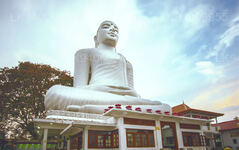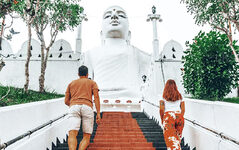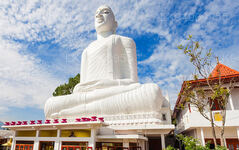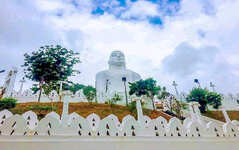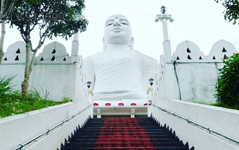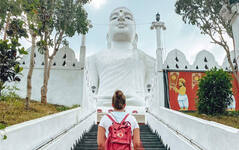
Kandy-stad
Kandy, een pittoreske stad in centraal Sri Lanka, staat bekend om zijn rijke culturele erfgoed, levendige festivals en schilderachtige schoonheid. Gelegen tussen weelderige heuvels, herbergt de stad de Tempel van de Tand, een UNESCO-werelderfgoed, en biedt een fascinerende mix van geschiedenis en natuurlijke pracht.
Bahirawakanda Vihara Buddha Statue
Rising from a hill adjoining the holy city of Kandy is the giant Buddha statue of Bahirawa Kanda. The statue is a mere 2km from the Temple of The Tooth Relic and was built in 1972.
Folklore
Many legends surround the hill of Bahirawa Kanda which means ‘gnome mountain’; and about how this statue came to be. Chief amongst these are two stories.
The first speaks of an ancient temple to the primitive god of protection, Bahiravar; which was implanted there during the reign of the Nayakkar Kings. During the olden days in India, the standard methods of worship for this god often involved animal sacrifice; though human sacrifice was never involved. But for some reason this practice seems to have gotten twisted in the localisation process; and the priests of this temple threatened the wrath of the god unless hundreds of virgin women were sacrificed in time. The naive people of the region handed over a large number of girls for sacrifice and lived in fear of the god’s wrath. However, this came to an end when the fiance of the Chief of the Royal Mahouts was taken for sacrifice. The man, whose name was Dunuwilla Gajanayake Nilame, used his power in the palace and his bravery to get her released; and caused such a great disturbance that the sacrificing ritual was broken. This marked the end of the people’s fear and superstition; and the temple was abandoned with time.
Another story speaks of how the hill gained the name ‘Gnome Mountain’ or ‘Devil’s Hill’. According to this legend there was a time in the past when the mountain emitted strange noises and engulfed the people who lived nearby in abject fear. They believed that it was the work of an evil gnome and searched for a way to appease it. Meanwhile, unknown to anyone, an actual gnome had infilitrated the palace and taken the place of one of the ministers. Realising the opportunity; the ‘minister’ advised the king that the gnome would be appeased if a beautiful virgin was sacrificed every year, and hence a new superstition began. But then one year; the nominated sacrifice was the lover of the fake minister’s very own son. The villagers kidnapped her during the night, took her to the hill and left her there. The minister’s son discovered this in the morning and immediately set off to rescue her. He fought the gnome , his father, who had been there for his own nefarious purposes; and returned to the village. The alarmed and fearful people had begun to wonder if the rescue of the sacrifice had angered the gnome; when the cunning son quickly made a gnome sound (after all he was a gnome too, being the son of the original gnome). The people the took this to mean that the sacrifice was accepted; and the couple left the village that same night, instead of risk having their trick being discovered.
The Statue and the Sights
The Bahirawakanda Buddha Statue is located alongside the Sri Maha Bodhi Temple which is on the top of the Bahirawa Kanda hill. This beautifully sculpted white statue displays Buddha in the seated Nirvana pose and can be seen from the entire city of Kandy that sprawls out before it. It stands at 88 feet in height and is one of the biggest Buddha statues in Sri Lanka.
Visitors can climb the top of the hill for panoramic views of the City of Kandy, the inside of Bogambara Prison, and the mountain range nearby. It makes for some spectacular photographs and memories. The temple of Bahirawa Kanda is open for worship. Devotees are required to remove their hats and shoes; and can offer flowers or light oil lamps. There is also set of stairs that run behind the Buddha statue, that allow visitors to climb to a greater height for better views of the landscape. However, the best time to visit Bahirawakanda is at night, when the entire statue is lit up and the city of Kandy spreads out in a map of twinkling lights.
Over het district Kandy
Het district Kandy ligt in de centrale provincie van Sri Lanka. Kandy, een van de zeven werelderfgoedlocaties in Sri Lanka, was ooit de thuisbasis van de Kandyaanse koningen van weleer in de 16e eeuw en een bron voor alle muziek, kunst, ambachten en cultuur in het land. Kandy ligt op ongeveer 129 km van Colombo en is genesteld in een heuvelachtig terrein en alle ogen worden getrokken naar het centrum van de stad, waar het Kandy-meer een charmant kenmerk vormt. Kandy behoudt een grote religieuze betekenis voor Sri Lanka, omdat in deze charmante stad de Dalada Maligawa of "Tempel van de Tand" zich bevindt, waarin de heilige tand van Boeddha goed bewaard wordt. De Koninklijke Botanische Tuin, Peradeniya, ligt ongeveer 5 km ten westen van het stadscentrum in Peradeniya en wordt jaarlijks door 1,2 miljoen mensen bezocht. Het is de grootste botanische tuin op het eiland. De Udawatta Kele (Udawatta-bos) is een beschermd heiligdom in het hart van de stad, net ten noorden van de Tempel van de Tand. Kandy is een stad met een Sinhalese meerderheid; er zijn aanzienlijke gemeenschappen die behoren tot andere etnische groepen, zoals Moren en Tamils. Kandy is, na Colombo, het centrum van de Sri Lankaanse economie. Veel grote bedrijven hebben grote vestigingen in Kandy en veel industrieën, waaronder textiel, meubels, informatietechnologie en sieraden, zijn hier te vinden. Veel landbouwonderzoekscentra bevinden zich in de stad. Het is tevens een bron van alle muziek, kunst, ambachten en cultuur van het land. Op ongeveer 129 km van Colombo ligt Kandy verscholen in een heuvelachtig gebied en alle ogen worden getrokken naar het centrum van de stad, waar het Kandymeer een charmant kenmerk vormt. Kandy heeft een grote religieuze betekenis voor Sri Lanka, omdat in deze charmante stad de Dalada Maligawa, oftewel Tempel van de Tand, is gevestigd, waar de heilige tand van Boeddha goed bewaard wordt.
Over de Centrale Provincie
De Centrale Provincie van Sri Lanka bestaat voornamelijk uit bergachtig terrein. De provincie heeft een oppervlakte van 5.674 km² en een bevolking van 2.421.148. Enkele belangrijke steden zijn Kandy, Gampola (24.730), Nuwara Eliya en Bandarawela. De bevolking is een mix van Singalezen, Tamils en Moren. Zowel de heuvelhoofdstad Kandy als de stad Nuwara Eliya, evenals Sri Pada, liggen in de Centrale Provincie. De provincie produceert een groot deel van de beroemde Ceylonthee, die in de jaren 1860 door de Britten werd geplant nadat een verwoestende ziekte alle koffieplantages in de provincie had vernietigd. De Centrale Provincie trekt veel toeristen, met heuvelstadjes zoals Kandy, Gampola, Hatton en Nuwara Eliya. De Tempeltand, of Dalada Maligawa, is de belangrijkste heilige plaats in de provincie Centrel. Het klimaat is koel en veel gebieden boven de 1500 meter hoogte hebben vaak koude nachten. De westelijke hellingen zijn erg nat, met op sommige plaatsen bijna 7000 mm regen per jaar. De oostelijke hellingen behoren tot de middeldroge zone, omdat ze alleen regen ontvangen van de noordoostelijke moesson. De temperaturen variëren van 24 °C in Kandy tot slechts 16 °C in Nuwara Eliya, dat 1889 m boven zeeniveau ligt. De hoogste bergen van Sri Lanka liggen in de Centrale Provincie. Het terrein is overwegend bergachtig, met diepe valleien die het doorsnijden. De twee belangrijkste berggebieden zijn het Centraal Massief en het Knuckles-gebergte ten oosten van Kandy.

